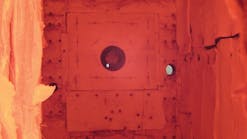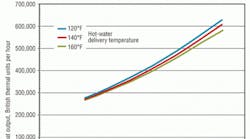A confluence of economic, environmental, and national-security concerns has led to renewed interest in natural-gas heating. Natural gas is an obvious choice for heating; it is readily available, is cost-effective, and has the lowest carbon content of any fossil fuel. But while the use of natural-gas heating has increased, technology largely has failed to keep pace. The traditional approach of heating fluid with a flame remains largely unchanged and results in appliances with 85- to 95-percent efficiency.
Natural-gas-engine-driven heat pumps offer an economic alternative to gas boilers. While the concept of a natural-gas-engine-driven heat pump is not new, advances in internal-combustion-engine technology in the automobile industry have led to significant improvements in reliability and efficiency. Additionally, new emissions-control technology has led to cleaner emissions and lower criteria pollutants (contributors to smog).
Traditional heating methods that involve the combustion of fossil fuels do not fully extract the chemical energy of the fuels because they rely solely on the transfer of thermal energy via cooling of hot gases. By contrast, a heat-pump cycle capitalizes on the availability of the combustion process by producing work via an engine to move heat from a cold reservoir to a warm reservoir through a standard Carnot cycle. The amount of heat that can be moved is many times the heat contained in the fuel powering the machine, providing a two- to threefold benefit.
This Carnot-efficiency benefit is shared by electric-motor- and gas-engine-driven heat pumps. With a gas engine, however, additional waste heat can be recovered and added to overall heat output, boosting efficiency by more than 30 percent. A typical engine-driven heat pump, coupled with recovered heat from the engine jacket and exhaust, can achieve a coefficient of performance (COP) of 1.4 to 2.0, more than doubling the COP of conventional water heaters (0.85). Moreover, an engine-driven heat pump burns half of the fuel and emits proportionately less carbon.
A natural-gas-engine-driven heat pump traditionally consists of a vapor-compression refrigeration cycle that includes a condenser, an evaporator, a throttling valve, and a compressor. Compressor-shaft work is provided by a reciprocating engine.
Rationale for Development
Generating electricity at a central plant is inherently inefficient, as 50 to 60 percent of the input energy is rejected to the environment in the form of low-grade waste heat. There also is an additional 3- to 5-percent loss associated with transmission through the grid and a 3- to 5-percent loss in electric-motor efficiency.
Through location of the fuel-conversion process on site via a natural-gas engine, the majority of waste heat from the engine can be recovered and purposefully used. Although a typical internal-combustion engine has a thermal efficiency of 30 to 35 percent, recovering up to 85 percent of the remaining energy, which normally would be lost as waste heat, is common in mechanical combined heat and power (CHP).
Technical Advantages
Today’s engine-driven heat pumps benefit from developments in the automotive industry. With electronic ignition, coil-on-plug technology, and an improved cylinder-head design providing a cleaner, more efficient burn, the days of changing plugs and wires with every oil change are history.
Improvements seen in cars, such as those from variable valve timing and advanced engine cycles (i.e., the Atkinson cycle used in many hybrid cars), can benefit gas-engine-driven heat pumps. Constant valve adjustments no longer are necessary, as engines have “set-for-life” valve trains. Improved synthetic oils coupled with large dry-sump oiling systems provide thousands of hours between simple oil and filter changes.
Improved air-fuel-ratio control has allowed the use of multiple-stage catalytic-converter systems to reduce levels of criteria pollutants, such as nitrogen oxides and carbon monoxide, to well below the levels of current boiler technology.
System Design, Implementation
Commercial natural-gas-engine-driven-heat-pump water heaters are available in many configurations and utilize a multitude of sources for evaporator heat extraction. When an air-cooled evaporator is utilized, heat is extracted from outdoor air through a coil. As with any air-source heat pump, overall COP is a function of outdoor, or “source,” temperature, following the Second Law of Thermodynamics or, in simpler terms, Carnot efficiency. Efficiency will increase as the source (air) and sink (hot-water) temperatures approach one another.
As performance varies with source temperature, so does heating capacity. An air-source-heat-pump hot-water heater provides the most heat when the outdoor or source temperature is highest. As outdoor temperature decreases, so does heat-pump capacity. This is attributed to the decrease in compressor suction temperature as outdoor temperature decreases, reducing refrigerant density and mass-flow rate through the compressor. As a result, net refrigerating effect decreases.
The advantage of heat pumps in general is that a COP many times greater than unity is possible. COP is defined by the following equation:
COP = energy out ÷ energy in
With boilers, COP is constant and never can be greater than unity, as the best-possible scenario is that all of the chemical energy in the fuel is utilized to heat water, with nothing wasted. Figure 1 shows the relationship between output and outdoor temperature. Figure 2 shows typical COP curves as outdoor temperature changes.
An air-source-heat-pump hot-water heater should be installed so that it can meet the entire load during summer, when its output is greatest (“base loading”). This is essential to increasing run hours and, thus, overall savings.
During warm months, a heat pump will act as the primary water heater for a facility; as ambient temperatures cool during winter, it can supplement a traditional boiler. This works well for retrofits, as it often can prevent large oversized boilers from running inefficiently during summer to serve domestic-hot-water or pool-heating loads in the absence of space-heating duties. In new construction, a heat pump has the advantage of replacing one or more boilers or sharing the load with a smaller boiler.
Consistent with Carnot efficiency, gas-engine-driven-heat-pump hot-water heaters are most efficient when output water temperature is lowest. Such applications include domestic hot water, pool heating, and radiant floors. Industrial processes, such as manufacturing and food production, also are good applications.
With current technology, maximum delivered-water temperature typically is 170°F. In existing buildings, heat pumps need to be sized to “base load” the building to prevent unnecessary cycling and part-load operation.
The simplest way to integrate a gas-engine-driven-heat-pump water heater is to use a primary/secondary piping configuration so that water enters the heating loop before it returns to the boiler. This applies to building heating loops, pool heating, and indirect domestic hot-water heating. Controls can be configured so that the boiler set-point is slightly lower than the heat-pump outlet temperature, which will prevent the boiler from running when the more efficient heat pump can meet a load on its own. This commonly is referred to as a “first on, last off” configuration.
Figure 3 shows a simplified connection to a heating loop serving multiple loads.
Depending on the configuration of a unit, whether the unit is indoor or outdoor, and whether the water is potable, an isolation heat exchanger may be necessary. In such a case, an additional heat exchanger and pump will need to be sized and considered in the economic analysis.
Maintenance
Engine life can be upward of 20,000 hr with adherence to recommended oil-change intervals, which vary according to site, run hours, load, and oiling system. With most current technology, oil changes are required no more frequently than bimonthly. Most manufacturers provide an optional factory-service contract.
Economic Benefits
For applications with significant hot-water requirements, such as water parks, swimming pools, hotels, hospitals, apartment buildings, and recreation centers, a natural-gas-engine-driven heat pump can cut fuel consumption and carbon emissions by half. Factors that contribute to the economic performance and savings that can be realized through the installation of a natural-gas-engine-driven heat pump include:
- Ambient temperature. An air-source heat pump extracts air from the ambient environment. System efficiency and corresponding savings, therefore, differ based on ambient weather conditions. Efficiency will be higher and fuel savings greater in warmer climates with higher ambient temperatures than in cooler climates. As shown in Figure 4, not all geographic areas are equal from an ambient-temperature perspective.
- Run hours. The installed cost of an air-source heat pump is the same whether the heat pump runs around the clock or not at all. For each hour it runs, a heat pump saves fuel in comparison with less efficient existing equipment. Longer run hours allow increased savings and, thus, decreased payback period. For this reason, it is essential to utilize a natural-gas-engine-driven heat pump in an environment with a significant thermal load where it can be first on and last off so that run hours are maximized.
- Relative fuel price. Table 1 shows savings that can be realized at various locations throughout the country based on ambient temperature, run hours, and local fuel price.
Federal investment tax credits and accelerated depreciation are available for qualified CHP products, including natural-gas-engine-driven heat pumps. A qualified tax professional can determine benefits available to you and your clients. Additionally, incentives may be available through your local gas utility or state and local agencies. These incentives can reduce the payback time for a natural-gas-engine-driven heat pump substantially. The payback for a typical natural-gas-engine-driven heat pump is between two and four years, depending on ambient temperature, thermal load, fuel cost, and available incentives.
Conclusion
Natural-gas-engine-driven heat pumps represent an outstanding opportunity to reduce hot-water-heating costs and lower greenhouse-gas emissions. Stable natural-gas supply and increased focus on energy costs, energy efficiency, and responsible environmental management will increase the use of natural-gas-engine-driven heat pumps.
Martin J. McDonough is president of Ilios Dynamics, a wholly owned subsidiary of Tecogen Inc. Stephen Lafaille is a product-development engineer with Ilios Dynamics/Tecogen Inc.
Did you find this article useful? Send comments and suggestions to Executive Editor Scott Arnold at [email protected].









